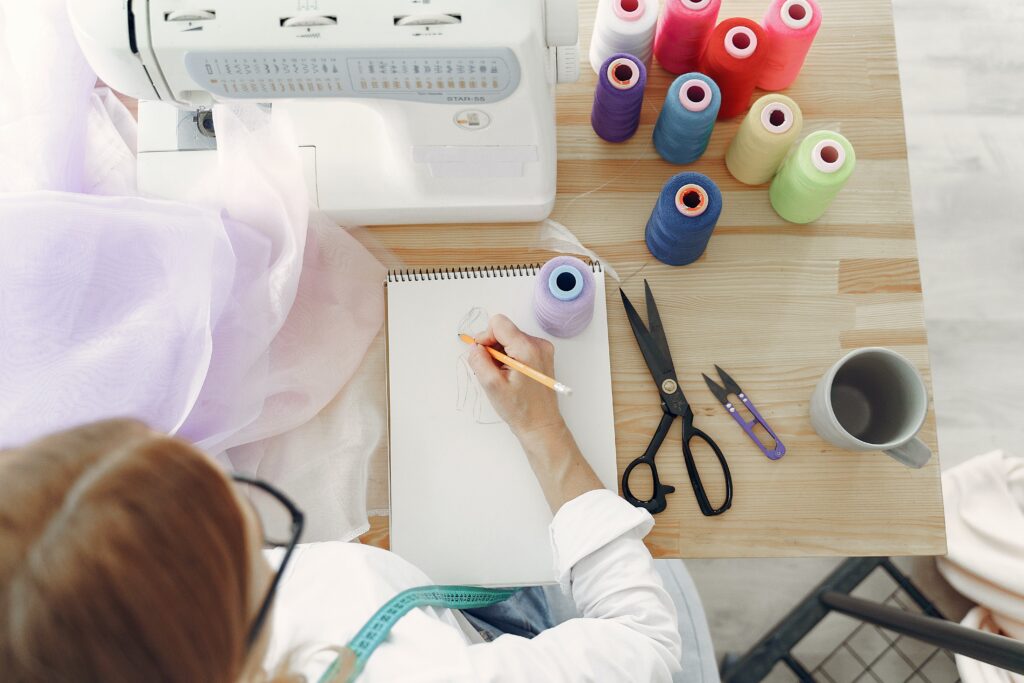Unlock the secrets to successful client communication in the dynamic world of fashion design in our blog Positive Client Communication in the World of Fashion Design: 7 Powerful Strategies”. From navigating language barriers to handling challenging personalities with grace, this guide provides practical insights to enhance your client interactions. Elevate your communication skills and cultivate lasting relationships, ensuring your journey in the realm of fashion design is not just successful but truly exceptional.”
Table of Contents
Introduction: Client Communication in the Domain of Fashion Design Building a Strong Foundation
Embarking on a successful design journey begins with the establishment of clear communication channels. Designers must dedicate time to comprehend their client’s expectations, preferences, and overarching vision for the project.
This initial step forms the bedrock of a collaborative partnership, guaranteeing alignment between both parties right from the start. By prioritizing effective communication, designers lay the groundwork for a harmonious and productive collaboration, setting the stage for the realization of a shared creative vision.

Active Listening in Design Consultations
The cornerstone of effective Client Communication in design is active listening. Designers must go beyond mere hearing; they need to listen with the intent to understand. In design consultations, the skill of extracting key details from clients takes center stage.
This demands the use of techniques such as asking probing questions, clarifying doubts, and ensuring that every nuance is captured. By prioritizing active listening, designers create a foundation for accurate design interpretation, fostering a collaborative environment where client expectations are not just heard but truly understood and translated into impactful design solutions.
Visual Aids and Concept Presentations
Visual aids stand as indispensable bridges between designers and clients. Mood boards, sketches, and concept presentations wield significant power in conveying design ideas effectively. Designers ought to dedicate time to craft visuals that align with the client’s preferences, offering a tangible representation of the envisioned final product.
This visual language not only enhances Client Communication but also ensures a shared understanding, allowing clients to actively engage with and contribute to the creative process. In investing effort into compelling visual aids, designers create a visually immersive experience that propels the design journey forward.
Feedback Handling Strategies
Embracing feedback as a catalyst for refinement, designers can foster a collaborative environment that not only meets but exceeds client expectations, ultimately elevating the quality and impact of the final design.
Constructive criticism is an inherent aspect of the design process, and designers should view feedback as a valuable resource for improvement. Navigating through critiques demands a delicate balance, where designers acknowledge the client’s input and incorporate changes without compromising the essence of the design.
Timely Updates and Project Milestones
Communication should not be sporadic; it’s crucial to provide regular updates on project progress. Designers ought to establish a clear timeline for milestones and keep clients informed at every stage. This commitment to transparency not only builds trust but also reassures clients that their project is advancing according to plan.

By maintaining a steady flow of information, designers create a collaborative environment that enhances client satisfaction and confidence in the design process.
Overcoming Language and Cultural Barriers
In our increasingly globalized industry, designers frequently collaborate with clients from diverse cultural backgrounds. Overcoming language barriers and understanding cultural nuances are crucial for effective communication. Designers should implement strategies that foster cross-cultural understanding, ensuring a seamless collaboration process. By embracing diversity and proactively addressing linguistic and cultural differences, designers create an inclusive and open environment that enhances communication, leading to more successful and culturally resonant design outcomes.
Resolving Design Dilemmas Together
Design challenges are inevitable, but involving clients in the decision-making process can turn obstacles into collaborative opportunities. This approach not only strengthens the client-designer relationship but also results in more satisfying design solutions.
Managing Expectations and Delivering Excellence
Setting realistic expectations from the outset is crucial. Designers should communicate project timelines, potential challenges, and expected outcomes transparently. By managing expectations effectively, designers not only build trust but also create the groundwork for exceeding client expectations.
This commitment to transparency and excellence ensures that the final results not only meet but surpass the envisioned outcomes, fostering client satisfaction and contributing to the overall success of the design endeavor.
Handling Difficult Clients with Grace
Dealing with challenging client personalities demands a delicate touch. Designers should proactively identify signs of difficulty early on and navigate conflicts with professionalism. Maintaining a positive and solution-oriented approach can often transform challenging situations into opportunities for growth.
By addressing concerns gracefully and finding constructive resolutions, designers not only uphold their professionalism but also contribute to fostering a positive and collaborative client-designer relationship.
Post-Project Communication
Client communication extends beyond project completion. Building lasting relationships involves continuous post-project communication. Designers should actively seek feedback, express gratitude, and keep clients informed about new developments.
This ongoing engagement fosters a sense of loyalty and partnership, demonstrating a commitment to long-term collaboration and ensuring that clients remain valued even after the project’s conclusion.
Evolving Trends in Client Communication
As the fashion industry evolves, so does communication. Designers must stay ahead by embracing new and innovative communication methods. From active social media engagement to immersive virtual experiences, staying updated ensures that designers remain not only connected but also relevant in the ever-changing landscape.
Adapting to evolving trends in client communication becomes a strategic move, allowing designers to meet the dynamic expectations of clients and stay at the forefront of the industry’s ever-shifting dynamics.
You will also like : 2024 में सफलता की कुंजी “Fashion Designer Kaise Bane”
You may also like: Fine Arts –What Is It All About?
Case Studies: Successful Client Communication Stories
Real-life examples provide valuable insights. This section explores successful client-designer collaborations, highlighting key communication strategies that led to exceptional outcomes. By learning from these examples/ case studies given below, designers can glean practical tips for their own projects.
i) Proactive Communication:
Example: Designer A maintained regular communication with the client throughout the project, sharing progress updates and addressing concerns promptly. This proactive approach ensured a smooth collaboration and a highly satisfied client.
ii) Clear Expectation Setting:
Example: Designer B clearly communicated project timelines, potential challenges, and expected outcomes at the project’s onset. This transparency not only managed the client’s expectations effectively but also laid the groundwork for a successful project delivery.

iii) Post-Project Engagement:
Example: Designer C didn’t stop communication after project completion. They sought feedback, expressed gratitude, and provided updates on future projects. This post-project engagement resulted in a long-term client-designer relationship.
iv) Navigating Challenges Professionally:
Example: Designer D faced challenges during a project but navigated conflicts professionally. By maintaining a positive and solution-oriented approach, they not only resolved issues but also strengthened the client’s trust in their expertise.
v) Embracing New Communication Methods:
Example: Designer E incorporated social media engagement and immersive virtual experiences to communicate with clients. This adaptation to evolving trends showcased a commitment to staying relevant in the industry’s ever-changing landscape.
In exploring these case studies, designers can extract practical insights, understanding how effective communication strategies contribute to successful client-designer collaborations.
Conclusion:
In conclusion, effective client communication is not merely a skill; it stands as a crucial cornerstone of success in the dynamic domain of fashion design.
Designers who prioritize clear communication, active listening, and adaptability to evolving trends elevate not only their craft but also create memorable experiences for their clients. In a field where collaboration is key, the ability to convey ideas, navigate challenges gracefully, and stay attuned to client needs becomes the hallmark of a designer’s excellence.
As designers continue to refine and enhance their communication strategies, they pave the way for enduring client relationships and the continued evolution of the fashion design industry.
You may also like: Unveiling the Power of Blockchain Technology: Changing Future
You may also like: 2024 Navigating the NFT Landscape : Unveiling the complexity of Non-Fungible Tokens
You may also like: 20 METAVERSE Realities Redefining the Virtual Revolution
You may also like: Internet of Things (IoT)-10 Mind-Blowing Secrets
Frequently Asked Questions (FAQ)
Q1: How can designers navigate language barriers when working with clients from different cultural backgrounds?
Designers can navigate language barriers effectively by:Utilizing professional interpreters if needed, Simplifying language without sacrificing clarity, Embracing visual aids to supplement verbal communication, Actively seeking feedback to ensure mutual understanding, Promoting an open dialogue for clients to express concerns or misunderstandings.
Q2: How can designers handle challenging client personalities with professionalism?
Handling challenging client personalities involves:Identifying signs of difficulty early on, Maintaining a positive and solution-oriented approach, Actively listening to concerns and addressing them gracefully, Setting clear boundaries while remaining flexible and adaptive, Seeking constructive resolutions to conflicts and conflicts.
Q3: What are the key elements of successful post-project communication with clients?
Successful post-project communication includes: Seeking client feedback for continuous improvement, Expressing gratitude for the collaboration, Keeping clients informed about future developments or projects, Fostering a sense of loyalty through ongoing engagement, Demonstrating a commitment to long-term relationships.
Q4: What role do visual aids play in enhancing client communication in fashion design?
Visual aids are crucial in enhancing client communication by: Providing tangible representations of design ideas, Creating a shared visual language for better understanding, Clarifying concepts, especially in cross-cultural collaborations, Facilitating discussions on design elements, colors, and styles, Elevating the overall client experience through immersive presentations.
Q5: How can designers stay updated with evolving trends in communication within the fashion industry?
To stay updated with evolving communication trends, designers can: Actively engage with social media platforms, Participate in industry forums, webinars, and conferences, Embrace emerging technologies like virtual reality and augmented reality, Network with peers and mentors to exchange insights Continuously educate themselves on the latest tools and platforms in the communication landscape.
